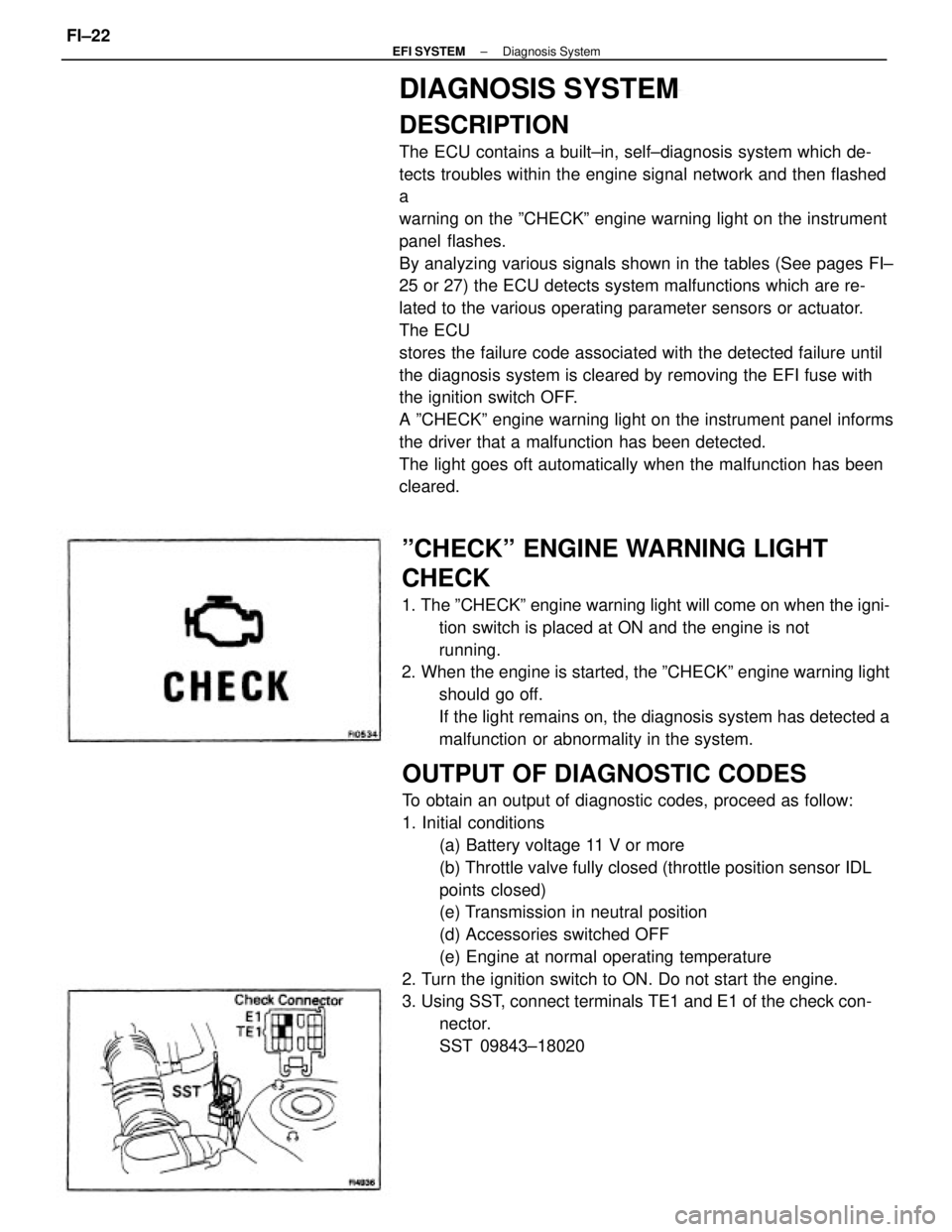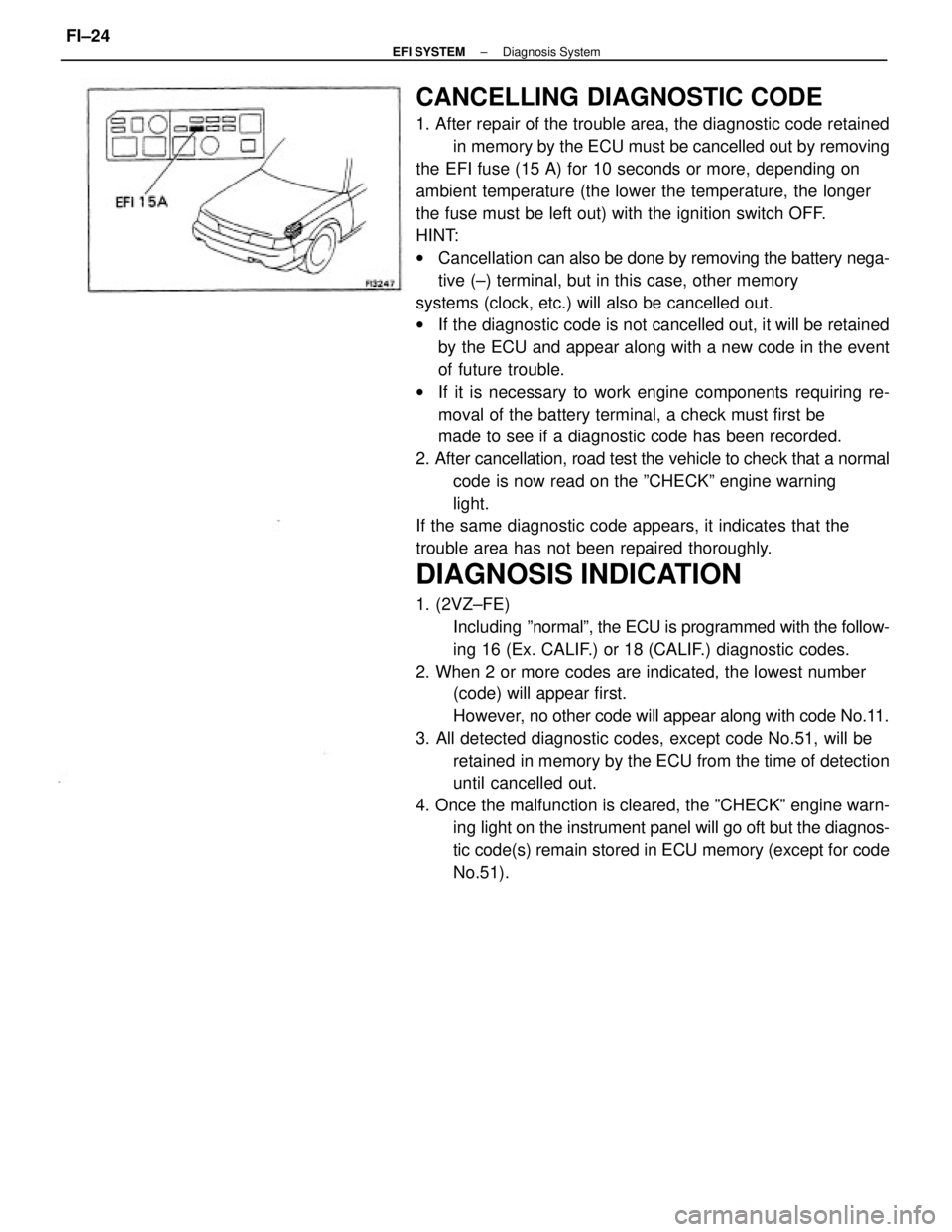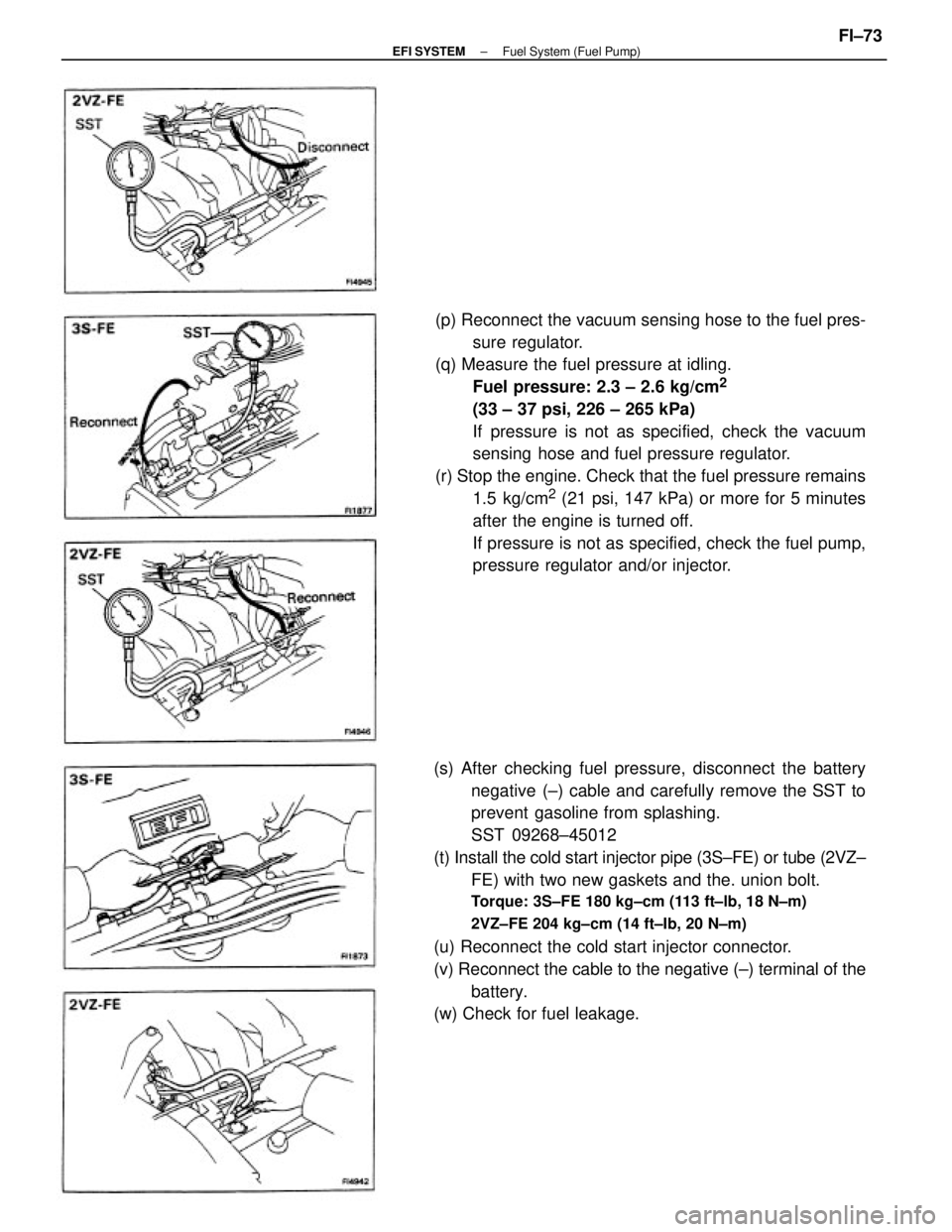Page 1036 of 2389

DIAGNOSIS SYSTEM
DESCRIPTION
The ECU contains a built±in, self±diagnosis system which de-
tects troubles within the engine signal network and then flashed
a
warning on the ºCHECKº engine warning light on the instrument
panel flashes.
By analyzing various signals shown in the tables (See pages FI±
25 or 27) the ECU detects system malfunctions which are re-
lated to the various operating parameter sensors or actuator.
The ECU
stores the failure code associated with the detected failure until
the diagnosis system is cleared by removing the EFI fuse with
the ignition switch OFF.
A ºCHECKº engine warning light on the instrument panel informs
the driver that a malfunction has been detected.
The light goes oft automatically when the malfunction has been
cleared.
OUTPUT OF DIAGNOSTIC CODES
To obtain an output of diagnostic codes, proceed as follow:
1. Initial conditions
(a) Battery voltage 11 V or more
(b) Throttle valve fully closed (throttle position sensor IDL
points closed)
(e) Transmission in neutral position
(d) Accessories switched OFF
(e) Engine at normal operating temperature
2. Turn the ignition switch to ON. Do not start the engine.
3. Using SST, connect terminals TE1 and E1 of the check con-
nector.
SST 09843±18020
ºCHECKº ENGINE WARNING LIGHT
CHECK
1. The ºCHECKº engine warning light will come on when the igni-
tion switch is placed at ON and the engine is not
running.
2. When the engine is started, the ºCHECKº engine warning light
should go off.
If the light remains on, the diagnosis system has detected a
malfunction or abnormality in the system.
± EFI SYSTEMDiagnosis SystemFI±22
Page 1038 of 2389

CANCELLING DIAGNOSTIC CODE
1. After repair of the trouble area, the diagnostic code retained
in memory by the ECU must be cancelled out by removing
the EFI fuse (15 A) for 10 seconds or more, depending on
ambient temperature (the lower the temperature, the longer
the fuse must be left out) with the ignition switch OFF.
HINT:
wCancellation can also be done by removing the battery nega-
tive (±) terminal, but in this case, other memory
systems (clock, etc.) will also be cancelled out.
wIf the diagnostic code is not cancelled out, it will be retained
by the ECU and appear along with a new code in the event
of future trouble.
wIf it is necessary to work engine components requiring re-
moval of the battery terminal, a check must first be
made to see if a diagnostic code has been recorded.
2. After cancellation, road test the vehicle to check that a normal
code is now read on the ºCHECKº engine warning
light.
If the same diagnostic code appears, it indicates that the
trouble area has not been repaired thoroughly.
DIAGNOSIS INDICATION
1. (2VZ±FE)
Including ºnormalº, the ECU is programmed with the follow-
ing 16 (Ex. CALIF.) or 18 (CALIF.) diagnostic codes.
2. When 2 or more codes are indicated, the lowest number
(code) will appear first.
However, no other code will appear along with code No.11.
3. All detected diagnostic codes, except code No.51, will be
retained in memory by the ECU from the time of detection
until cancelled out.
4. Once the malfunction is cleared, the ºCHECKº engine warn-
ing light on the instrument panel will go oft but the diagnos-
tic code(s) remain stored in ECU memory (except for code
No.51).
± EFI SYSTEMDiagnosis SystemFI±24
Page 1048 of 2389
(f) Install SST (pressure gauge) to the delivery pipe (3S±
FE) or LH delivery pipe (2VZ±FE) with new two gas-
kets and the union bolt.
SST 09268±45012
Torque: 3S±FE 180 kg±cm (13 ft±Ib, 18 N±m)
2VZ±FE 200 kg±cm (14 ft±lb, 20 N ±m)
(g) Wipe off any splattered gasoline.
(h) Reconnect the battery negative H cable. (c) Disconnect the cold start injector connector.
(d) Put a suitable container or shop towel under the cold
start injector pipe (3S±FE) or tube (2VZ±FE).
(e) Remove the union bolt and two gaskets, and discon-
nect the cold start injector tube from the delivery pipe
(3S±FE) or LH delivery pipe (2VZ±FE).
HINT: Slowly loosen the union bolt. 2. CHECK FUEL PRESSURE
(a) Check the battery voltage is above 12 volts.
(b) Disconnect the cable from the negative (±) terminal of the
battery.
± EFI SYSTEMFuel System (Fuel Pump)FI±71
Page 1050 of 2389

(s) After checking fuel pressure, disconnect the battery
negative (±) cable and carefully remove the SST to
prevent gasoline from splashing.
SST 09268±45012
(t) Install the cold start injector pipe (3S±FE) or tube (2VZ±
FE) with two new gaskets and the. union bolt.
Torque: 3S±FE 180 kg±cm (113 ft±lb, 18 N±m)
2VZ±FE 204 kg±cm (14 ft±Ib, 20 N±m)
(u) Reconnect the cold start injector connector.
(v) Reconnect the cable to the negative (±) terminal of the
battery.
(w) Check for fuel leakage.(p) Reconnect the vacuum sensing hose to the fuel pres-
sure regulator.
(q) Measure the fuel pressure at idling.
Fuel pressure: 2.3 ± 2.6 kg/cm
2
(33 ± 37 psi, 226 ± 265 kPa)
If pressure is not as specified, check the vacuum
sensing hose and fuel pressure regulator.
(r) Stop the engine. Check that the fuel pressure remains
1.5 kg/cm
2 (21 psi, 147 kPa) or more for 5 minutes
after the engine is turned off.
If pressure is not as specified, check the fuel pump,
pressure regulator and/or injector.
± EFI SYSTEMFuel System (Fuel Pump)FI±73
Page 1051 of 2389
REMOVAL OF FUEL PUMP
CAUTION: Do not smoke or work near an open flame when
working the fuel pump.
1. DISCONNECT CABLE FROM NEGATIVE TERMINAL
OF BATTERY
2. REMOVE FUEL TANK
4. REMOVE FUEL PUMP FROM FUEL PUMP BRACKET
(a) Pull off the lower side of the fuel pump from the bracket.
(b) Remove the two nuts, and disconnect the wires from the fuel
pump.
(c) Disconnect the fuel hose from the fuel pump.3. REMOVE FUEL PUMP BRACKET FROM FUEL TANK
(a) Remove the bolt of the bracket.
(b) Remove the seven screws, pull out the pump bracket.
COMPONENTS (2WD)
± EFI SYSTEMFuel System (Fuel PumpFI±74
Page 1052 of 2389
4. INSTALL FUEL TANK
When installing the fuel tank, refer to FI±65 for the installation
position of the cushion and the tightening torque.
5. CONNECT CABLE TO NEGATIVE TERMINAL OF
BATTERY 2. INSTALL FUEL PUMP TO FUEL PUMP BRACKET
(a) Connect the fuel hose to the outlet port of the fuel pump.
(b) Connect the wires to the fuel pump with the two nuts.
(e) Push the lower side of the fuel pump, and install the fuel
pump.
3. INSTALL FUEL PUMP BRACKET TO FUEL TANK
(a) Install a new gasket and the pump bracket with the seven
screws.
Torque: 40 kg±cm (35 in.±lb, 3.9 N±m)
(b) Install the bolt of the bracket.
INSTALLATION OF FUEL PUMP
(See page FI±74)
1. INSTALL FUEL PUMP FILTER TO FUEL PUMP
(a) Install the pump filter with a new clip.
(b) Install the rubber cushion.5. REMOVE FUEL PUMP FILTER FROM FUEL PUMP
(a) Remove the rubber cushion.
(b) Using a small screwdriver, remove the clip.
(c) Pull out the pump filter.
± EFI SYSTEMFuel System (Fuel Pump)_FI±75
Page 1053 of 2389
REMOVAL OF FUEL PUMP
CAUTION: Do not smoke or work near an open flame when
working the fuel pump.
1. DISCONNECT CABLE FROM NEGATIVE TERMINAL
OF BATTERY
2. REMOVE FUEL TANK
4. REMOVE FUEL PUMP±FROM FUEL PUMP BRACKET
(a) Pull off the lower side of the fuel pump from the bracket.
(b) Remove the two nuts, and disconnect the wires from the fuel
pump.
(c) Disconnect the fuel hose from the fuel pump. 3. REMOVE FUEL PUMP BRACKET FROM FUEL TANK
Remove the seven bolts, pull out the pump bracket.
COMPONENTS (4WD)
± EFI SYSTEMFuel System (Fuel Pump)FI±76
Page 1054 of 2389
2. INSTALL FUEL PUMP TO FUEL PUMP BRACKET
(a) Connect the fuel hose to the outlet port of the fuel pump.
(b) Connect the wires to the fuel pump with the two nuts.
(c) Push the lower side of the fuel pump, and install the fuel
pump.
4. INSTALL FUEL TANK
When installing the fuel tank, refer to FI±65 for the installation
position of the cushion and the tightening torque.
5. CONNECT CABLE TO NEGATIVE TERMINAL OF
BATTERY INSTALLATION OF FUEL PUMP
(See page FI±76)
1. INSTALL FUEL PUMP FILTER TO FUEL PUMP
(a) Install the pump filter with a new clip.
(b) Install the rubber cushion.
3. INSTALL FUEL PUMP BRACKET TO FUEL TANK
Install a new gasket and the pump bracket with the seven
bolts.
Torque: 30 kg±cm (26 in.±lb, 2.9 N±m)
5. REMOVE FUEL PUMP FILTER FROM FUEL PUMP
(a) Remove the rubber cushion.
(b) Using a small screwdriver, remove the clip.
(e) Pull out the pump filter.
± EFI SYSTEMFuel System (Fuel Pump)FI±77